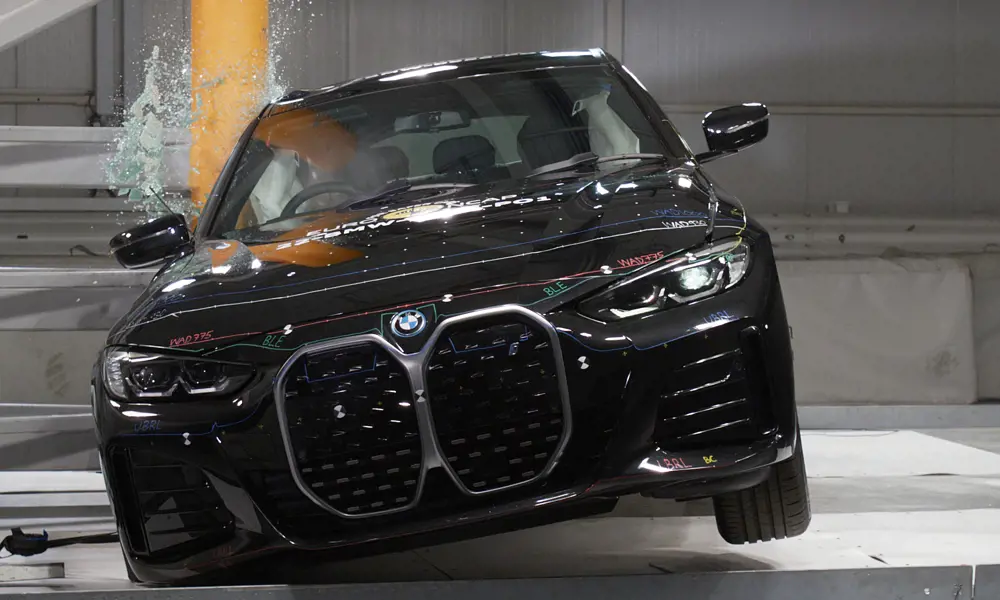
How crashing cars can help us make them safer
Did you know?
What did we use before crash test dummies were invented?
- Crash test dummies didn’t exist until the 1970s, before which cadavers, live human volunteers and even animals were used in testing
- Until recently, only three models of dummy were used in testing and these didn’t represent a large majority of women
- In a high severity test, the crash itself takes just 200 milliseconds
Each year, there are around 126,200 road accidents in Great Britain. On average five people a day die on the road, while 84 are seriously injured. Safety of the vehicles we drive and use is critically important. To give consumers transparent information about the cars they are choosing to buy, every new model of car that goes on sale in the UK must undergo impact testing to assess its safety, provide consumers with a guide to that safety and give manufacturers clear safety requirements.
A form of destructive testing, impact testing is often used to assess the safety of road vehicles. It also extends to other modes of transport, such as rail, aircraft and wheelchairs; protective clothing such as hardhats and protective vests; and packaging.
The process typically involves simulating an impact in a controlled facility. This could be, for example, crashing a moving vehicle into a wall and gathering data from high-speed cameras, triaxial accelerometers, and a host of sensors embedded in crash test dummies to measure the potential damage in different impact scenarios. A team of design engineers, materials engineers and computer simulation engineers then use the data to improve safety design of what’s being tested, whether a vehicle, item of protective clothing or even packaging.
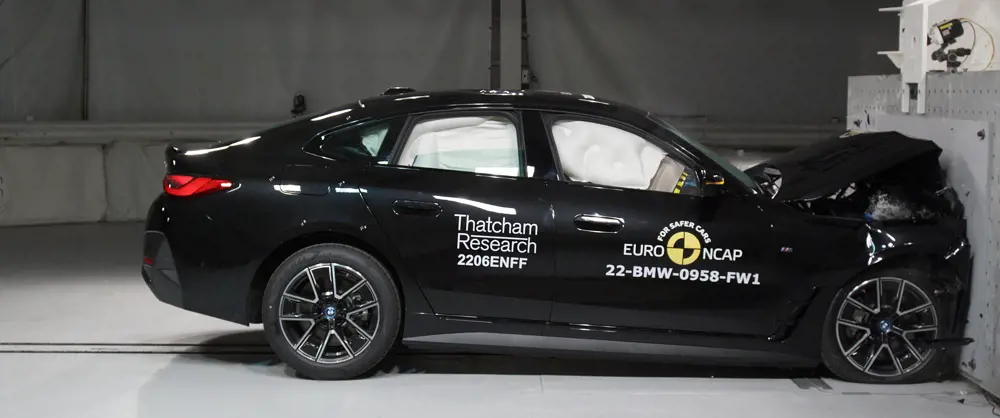
A BMW i4 during crash testing © Thatcham Research
“…Our aim is to reduce the number of people who are killed or seriously injured on European roads,” says Alex Thompson, simply. As well as being Principal Engineer for Automotive Safety at Thatcham Research, Thompson is a lead inspector for Euro NCAP (the European New Car Assessment programme), which tests cars and provides independent safety ratings to consumers.
“At the other end of the scale, we also perform ‘low severity’ crash tests that represent the type of crashes that occur most frequently – that’s those at a much lower speed than the Euro NCAP tests, where occupants are unlikely to sustain any injury but the vehicle can still sustain a significant amount of damage.” The results of these tests inform insurance companies of how much damage a car might typically sustain from everyday, low-level impacts. “The aim there is to encourage vehicle manufacturers to design more repairable vehicles with affordable parts, and therefore reduce the cost of a vehicle’s insurance premiums and reduce waste,” he says.
A team of design engineers, materials engineers and computer simulation engineers use crash test data to improve safety design of what’s being tested.
How to test a vehicle
Assessing a vehicle for Euro NCAP involves four different ‘high severity’ crash tests, and other tests and assessments for how vehicles behave in a crash, as well as how good they are at preventing a crash from happening in the first place.
“It’s very exciting,” says Thompson. “We stand in the crash facility in a viewing area. All the lights go on. We have to have very bright lights for our high-speed cameras, that are running at 1,000 frames per second. We then make sure that everyone knows what’s happening and the test engineer knows we’re recording data. “Next, we have a countdown. In our facility, the vehicle starts out of sight. And our winch that tows the vehicle makes quite a bit of noise as it ramps up. There’s a build-up of noise as you get towards the point of the impact. “You get a woosh as the vehicle comes into the facility. In a typical frontal impact test, it’s about 40 mph (64 kmph) and most people comment that it looks really fast.
“At this crescendo of noise, the vehicle comes into the facility and then there’s this almighty bang. And most people are quite shaken by that. It’s very dramatic. The vehicle rebounds, and it’s over in the blink of an eye.
“I think people are shocked and a bit stunned at both the noise and then the aftermath of the crash, when all of a sudden the car is wrecked. The airbags have gone off. Then the winch motor dies and everything goes a bit silent.”
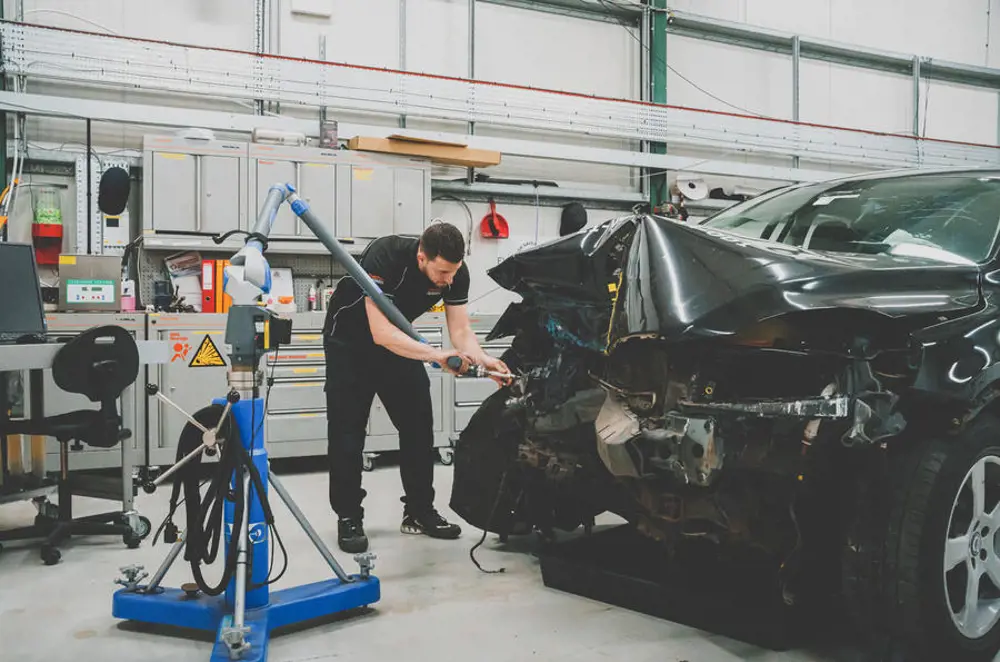
An engineer inspects the damage and takes post-crash measurements © Thatcham Research
Data and crash test dummies
Once the test has taken place, the team needs to document it by taking photos before and after to show exactly what happened, and data from the dummies and vehicles is downloaded and processed “We look at the high-speed films and, in combination with the data, we look at how the dummies have reacted during the impact, and whether the airbags have deployed correctly,” adds Thompson.
After the test, engineers must understand what the results might mean for real-life users of the car in question. Therefore, they need to set up the tests incredibly accurately.
Crash test dummies are highly engineered, fitted with hundreds of sensors and transducers that can tell crash test engineers what the likely effect on a living human occupant might have been in any given crash test. For example, the dummies developed by Humanetics – the largest manufacturer of crash test dummies – are fitted with sensors that indicate whether an occupant would suffer broken bones or damage to soft tissue.
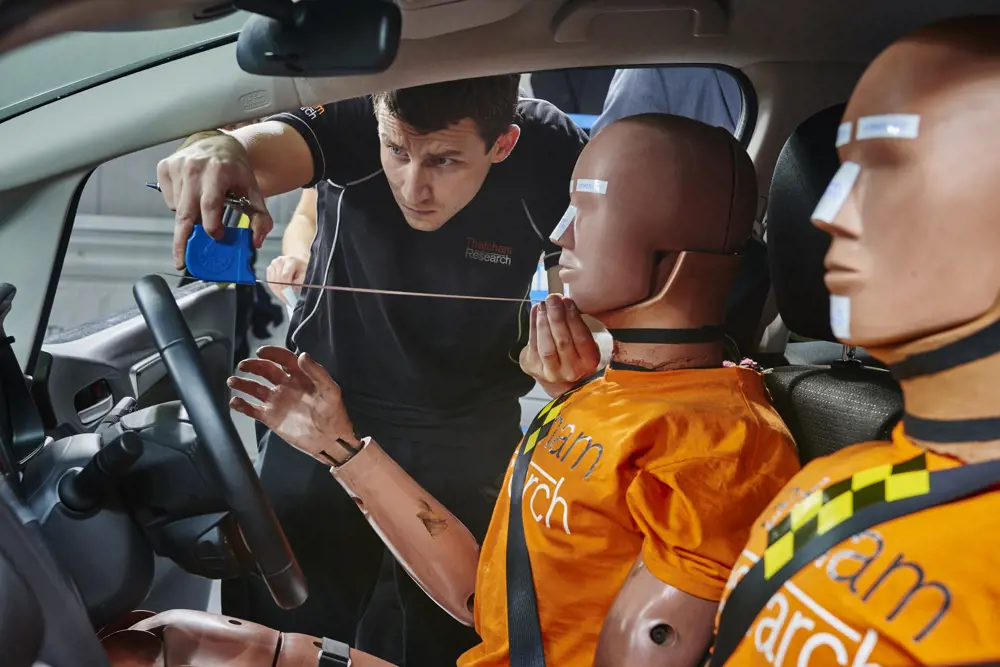
Crash test dummies must be positioned very accurately to ensure that test results are valid © Thatcham Research
“There are very small tolerances about how you position a dummy,” explains Thompson. “For example, we have a reference point on the dummy called the h-point, which is where the standard hip is. We have a tolerance of plus or minus 13 millimetres to position that dummy. So for that vehicle, for every crash test that happens, we should be within that window.” This level of accuracy allows the tests to be directly compared across different vehicles; any variation in dummy positioning would introduce too many variables.
However, humans do not sit in the same way as crash dummies. Thompson adds: “So, afterwards, we have to strip the car down and look at what might have happened if the dummy was sitting in a slightly different position. For example, where the knees may have impacted the fascia [part of the dashboard], we need to check if there are any hazards [such as other structural components in the car] around that area so that if a driver was sitting in a slightly different position to the dummy, is there likely to have been a worse performance than we saw in the test? We also have to look carefully at the vehicle structure, to see that if the crash was at a slightly higher speed, different overlap, different impact angle… we would likely have seen a significantly different result.”
Importantly, crash tests don’t promise to predict what would happen in any given crash scenario in a particular car. Rather, the tests provide a way to compare against other vehicles and provide a general overview of safety performance – what you might expect to happen to occupants, pedestrians, and the vehicle itself in a crash – as well as safety equipment in the vehicle such as airbags and autonomous braking systems. But it doesn’t come without its challenges.
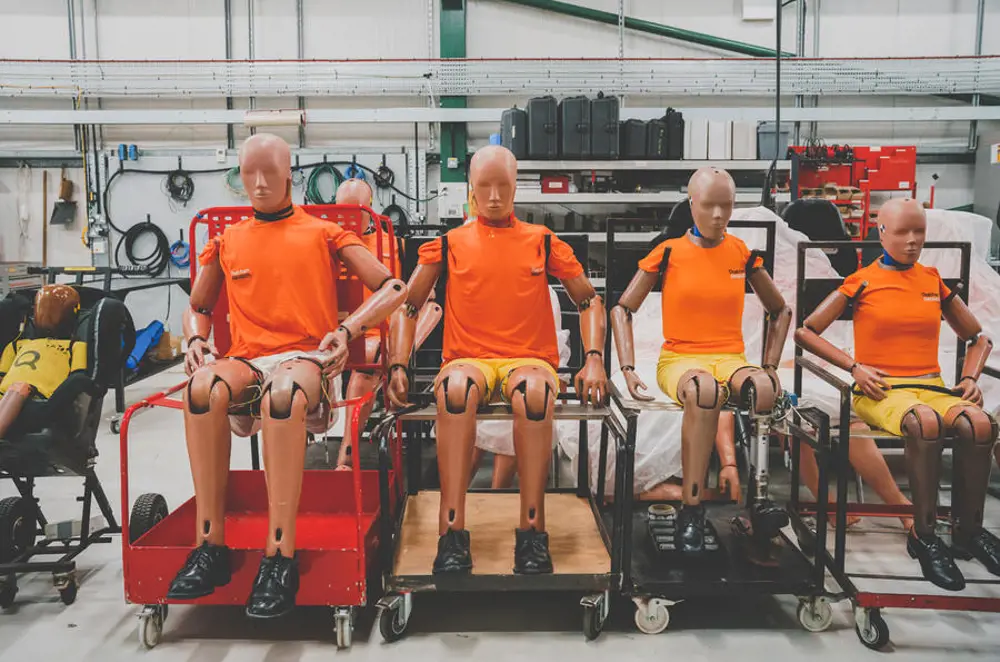
Hybrid-III 50th percentile male and 5th percentile female frontal impact crash dummies © Thatcham Research
How well do crash test dummies represent all body types?
In 2019, the Center for Applied Biomechanics at the University of Virginia published a study that found that women were 73% more likely to be injured than men in a frontal crash of the same speed and severity. Women are also three times more likely than men to suffer from whiplash injuries in rear impact crashes. These figures suggest that current vehicle design disproportionately benefits drivers who are men.
Today, there are three types of crash test dummies for adults used by EuroNCAP and the American equivalent, the National Highway Traffic Safety Administration (NHTSA). The ‘95th percentile male’ (188 cm tall and 100 kg), the ‘50th percentile male’ (175 cm tall and 77 kg) and the ‘5th percentile female’ (152 cm tall and 50 kg). These standards were developed in the 1970s and have remained the same ever since. (Before the 1970s – and even afterwards – cadavers, live human volunteers and animals such as chimpanzees, bears and pigs were used as crash test dummies.)
On the face of it, this sounds as if crash test dummies would represent most road users. “The 5th percentile female dummy takes into account a shorter driver that is sitting much closer to the steering wheel, and also a shorter rear occupant,” says Thompson.
But these ‘female’ dummies are merely scaled-down versions of the larger ones. Their proportions and body shape are the same as those of the male dummies, and they are roughly the size of a 12-year-old girl, not an average woman. The lack of representation of women road users in crash testing could go some way to explaining the discrepancy of road injuries by gender.
Fortunately, more realistic dummies are out there. In October 2022, a team of Swedish engineers led by Dr Astrid Linder developed the first crash test dummy designed to match the body shape, size and weight of an average woman (162 cm tall and 62 kg). Although these dummies are not yet a legal requirement for user tests such as Euro NCAP, Humanetics has developed dummies that represent road users who are ‘elderly’, ‘large and obese’, children of different sizes, and a 5th percentile female dummy with an adult woman’s shape. If and when regulations do change to include such diversity of dummies, it will be interesting to see whether vehicle safety design changes in response, and whether the real-world fatality figures improve for women and other vulnerable road users.
It is vital that engineers working in crash testing and vehicle safety policy are representative for the full spectrum of road users, to make everyone as safe as their ‘50th percentile male’ counterparts.
Planning the perfect crash
The biggest challenge with impact testing comes from its nature as a destructive test, so it needs to be right first time. “The most expensive I’ve personally tested has been well over £100,000 as a brand-new car,” says Thompson. “So, yeah, we simply don’t have a second opportunity.”
Part of the difficulty is the degree of accuracy required. “We have tolerances on the speed of impact that we need to achieve,” says Thompson. “For example, for a 64 kmph frontal impact test, we start the vehicle 80 metres away, and we have to hit the barrier that we’re impacting within a 20 millimetre tolerance. So, we have to be certain when we set everything up that it’s going to hit correctly. As well as that, making sure all the data is going to record, cameras are going to work. That’s really key.”
To mitigate the risk of a wasted test, preparation is everything. The team takes three or four days to prepare for a test and it has lengthy checklists. The crash itself takes just 200 milliseconds, followed by several days of data analysis. “We have to be absolutely spot on with everything that we’re doing,” adds Thompson. “Double checks, triple checks… and we have to not be afraid to say we’re not going to test it if there’s anything that flags up as being a concern.”
The most expensive I’ve personally tested has been well over £100,000 as a brand-new car. So, yeah, we simply don’t have a second opportunity.
Alex Thompson, Principal Engineer for Automotive Safety, Thatcham Research
Careers in impact testing
It was an undergraduate degree in mechanical engineering and answering a job advert for crash test engineers that led Thompson down his career path. Other routes into working with crash testing include apprenticeships to become a crash test vehicle technician. But for Thompson, the choice was also a personal one.
“My grandfather was involved in a very serious accident when I was a kid,” Thompson says. “Without endorsing any particular brand, he was driving a Volvo, which was designed with a crumple zone. He went head-on into an HGV, and this was pre airbags. But he survived, in a type of crash which, in those days, you potentially wouldn’t have done. So, I was very passionate about furthering vehicle safety.
“In terms of a career within engineering, it’s a very rewarding one. Having been in it for 22 years, you can see the change in vehicle design as vehicles have gotten safer and more safety equipment has been fitted. It really gives you a sense of pride in the work that we’ve done as crash test facilities and safety organisations in helping reduce the number of people who are killed and seriously injured on the roads."
Saving racing drivers
Impact testing has also revolutionised the world of motorsport. Engineers developed the Halo driver crash protection system using impact testing. The first tests using the technology started in 2016, and since 2018, the Fédération Internationale de l’Automobile (FIA), motorsport’s governing body, has made it mandatory on all vehicles raced in Formulas 1, 2, 3, 4, Regional, and E.
The halo is a structural feature on cars driven in these categories of race. It is made of titanium, surrounds the driver’s head and is connected to the vehicle frame in three places.
Using data from 40 real incidents, the FIA performed crash test simulations of vehicles with and without the Halo structure, in different scenarios: collision between two vehicles; contact between the vehicle and the environment, such as course barriers; and collisions between the vehicle and debris. They found that the Halo theoretically increased the survival rate of the driver by 17%.
The safety system attracted some criticism early on, with opponents complaining of its ugly aesthetics. However, several serious crashes following its adoption demonstrated its lifesaving capability. Halos have been landed on or struck by other cars, crashed into barriers, and even taken the entire car’s weight when they’ve been flipped upside down; in all cases, the drivers attributed their survival to the Halo.
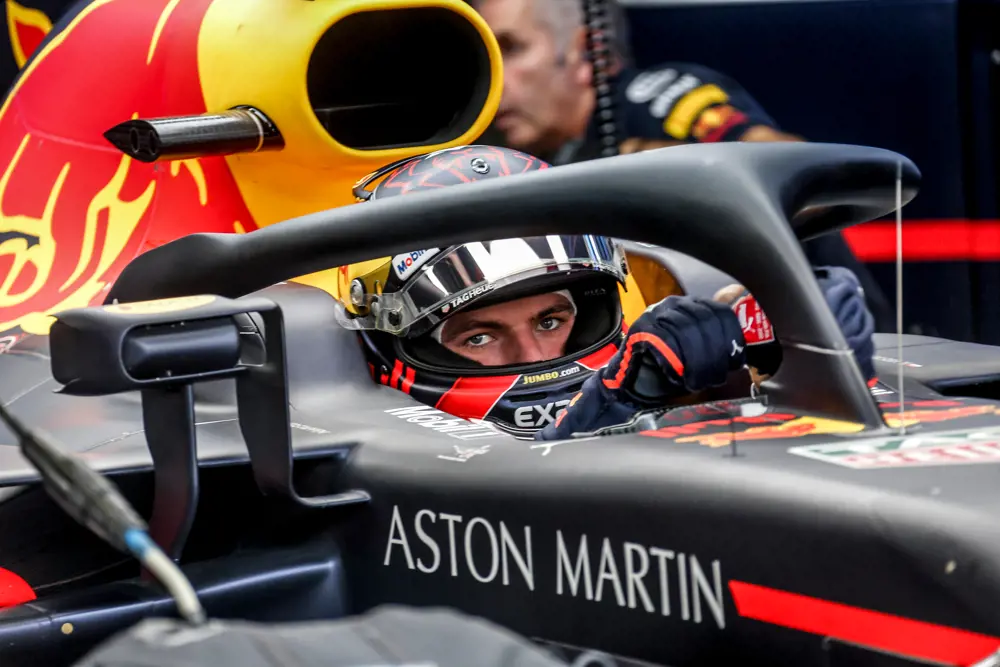
The Halo – the black T-shaped curved structure – is used on vehicles in motorsport racing to protect the driver’s head in crashes and from debris © Shutterstock
The future of impact testing
Impact testing must keep pace with the constantly changing landscape of vehicles on today’s roads. Consumer vehicles are changing rapidly, with additional safety technologies such as autonomous emergency braking becoming standard.
For example, the Global Vehicle Target was first introduced by Euro NCAP in 2014 to test autonomous emergency braking systems. These systems use sensors, such as cameras, radars and lidars, to detect potential hazards in front of the vehicle, and automatically apply the brakes to avoid a collision or mitigate its severity. For these tests, the impacts on real vehicles are tested on a remotely controlled ‘soft car’ that travels at speeds of up to 144 kmph and is recognised as any ordinary car would be by sensors on autonomous cars. Although it might disintegrate on impact, it can be reassembled in a matter of minutes, making it a lot cheaper than totalling a real car.
There are also assessments for systems designed to avoid collision with pedestrians and cyclists. As the vehicle systems change, the assessments must constantly evolve too, and EuroNCAP has added different scenarios to its tests since their first introduction, such as braking when a car turns across the path of an approaching vehicle.
“Over the next 50 years, we’re still going to see cars crashing,” says Thompson, “but we’re going to see cars crashing in different configurations as these systems potentially intervene and mitigate collisions.”
For example, if a car has already autonomously started to brake before a collision occurs, it is possible that the occupants might be in a slightly different position than they were before the brakes were applied. And, as vehicles become even more automated, we might see occupants reclining to take a nap or turning their seats round to chat or play games with the other occupants in the car. So, crash testing will need to adapt to these different scenarios.
“As these new technologies change the way that people use their vehicles and change the way that vehicles interact with each other, it’ll be vitally important that, if you do have a crash in that situation, you’ll be protected as you would be now.”
***
This article has been adapted from "Ensuring a safe impact", which originally appeared in the print edition of Ingenia 94 (March 2023).
Contributors
Alex Thompson started his career in crash testing in 2001, and has lost count of the number of cars that he has destroyed in the name of improving vehicle safety, both through consumer testing and research programmes. He is a Chartered Engineer, a Euro NCAP Lead Inspector and Thatcham’s subject matter expert for vehicle safety.
Dr Anna Ploszajski
Author
Keep up-to-date with Ingenia for free
SubscribeRelated content
Design & manufacturing

Super cool(er)
Welsh startup Sure Chill has developed a cooler that uses the properties of water to keep its contents cool for around 10 days without electricity. This is ideal for storing items such as vaccines where electricity sources are unreliable.

R&D investment makes good business sense
In just five years, Dr Ralf Speth FREng has presided over a revolution in design and manufacturing that has helped create a new family of engines and has overhauled Jaguar Land Rover (JLR) production facilities.

Steel can arise from the ashes of coal
Thousands of people were laid off in the UK steel industry in 2015 and there are pessimistic future forecasts. Professor Sridhar Seetharaman of the Warwick Manufacturing Group argues that smaller, flexible steel mills implementing new technology would better cope with fluctuating global trends.

Integrating metrology in business and academe
Professor Jane Jiang’s interest in measuring began when she worked on a bus production line in China. She found that the best way to improve quality, consistency and productivity was through metrology, the science of measurement. Today, she runs the UK’s largest metrology research group.
Other content from Ingenia
Quick read

- Environment & sustainability
- Opinion
A young engineer’s perspective on the good, the bad and the ugly of COP27

- Environment & sustainability
- Issue 95
How do we pay for net zero technologies?
Quick read

- Transport
- Mechanical
- How I got here
Electrifying trains and STEMAZING outreach

- Civil & structural
- Environment & sustainability
- Issue 95